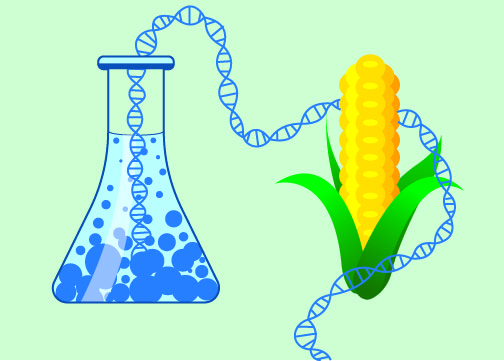The Debate Over GMOs
December 8, 2020
It is safe to say that corn is an easily recognizable crop. No one can mistake the bright kernels that line the outside for anything else. But corn has not always looked this way. Researchers believe teosinte, a grass native to Mexico, was the precursor to corn as we know it today. It has taken thousands of years of selective breeding to get the desirable traits that makes corn delicious and plentiful. By choosing the plants with the best traits to breed, corn has gone from a grass to America’s most grown and used crop. Selective breeding has been used throughout history to improve the foods humans eat. Today, technology is used to speed up the process at an incredible rate.
GMOs, or genetically modified organisms, are organisms whose traits have been modified using genetic engineering. DNA from another organism, such as bacteria, is used to give crops desirable traits, including better nutritional value and resistance to extreme conditions. However, the safety and predictability of GMOs have been debated and many are opting to avoid foods known to contain genetically modified ingredients. Claims of allergens, increased risk of cancer, and toxicity have brought up the question: are GMOs bad for our bodies?
At the grocery store, numerous products boasting about their lack of GMO ingredients line the shelves. In the produce section, ‘organic’ stickers stamped onto fruits and vegetables indicate to customers that the food was grown without genetic modification or pesticides. One might assume from these labels that a GMO is something to avoid. Freshman Ella Sharrers prefers not to buy GMO products. “It’s a modified version of what you expect going into your body,” says Sharrers. “You don’t know what they’ll do.” Sophomore John Moore favors organic foods as well. “Organics are more healthy than GMOs,” he says, although he does not believe GMOs are necessarily harmful.
There are many concerns over GMOs, including their impact on the environment. One concern may be a risk of the development of invasive superweeds that have a high resistance towards herbicides and pesticides. An example is the Morning Glory which, according to a Garden Organic article, became resistant towards an herbicide called glyphosate. “This was not something predicted by the genetic engineers,” the article claims. Genetically modified (GM) plants can also contaminate non-GM plants through cross-pollination, which can yield unexpected results. Contamination might lead to hybrids of GM and non-GM crops and thus hurt an organic farmer’s career. Some farmers also fear that cross-pollination reduces the diversity of crops.
A failure to use genetic engineering to improve rice caught the attention of some critics in 2016 when the U.S. Food and Drug Administration declared that the carefully developed ‘golden rice’ could not claim to provide enough Vitamin A. The golden rice was engineered with the purpose of preventing blindness due to a lack of Vitamin A by increasing the amount of beta-carotene rice contained. Golden rice had been in development for over twenty years, but it was not enough to make a notable difference. The underwhelming results of the project have been used as an example for anti-GMO groups to claim that genetic engineering of food is ineffective and unnecessary.
Although not every genetic engineering project has been successful, there have been many that brought change for the better. GMOs have many benefits, such as increased resistance to insects that allows for higher crop yields. Favorable traits have been added to crops such as soybeans, corn, potatoes, and cotton with genetic engineering. Apples are also an example of a food that has been improved by genetic modification. Some GM apples have developed anti-browning properties that make them last longer than non-GM apples.
Additionally, GMOs could be engineered to have a better impact on the environment than their non-GM counterparts. According to Ryan Raman from Healthline, GMOs can help reduce the use of chemical pesticides. “GMO technology has reduced chemical pesticide use by 37% and increased crop yields by 22%,” Raman states. Chemical pesticides can have harmful effects on humans and other animals such as cancer and hormone disruption. Eliminating the use of chemical pesticides would have a better impact on the environment, and GMOs can help reduce their use.
GMOs are considered safe by numerous government agencies such as the U.S. Food and Drug Administration. Senior Thomas Tastad says that if GMOs “were any way harmful, the FDA would not allow them to be given out to the vast majority of the public.”
So why are GMOs feared if they are considered safe to eat? Perhaps it is a lack of understanding exactly what they are and how they work. Stefaan Blancke, a writer for Scientific American, seems to think so. According to Blancke, a survey conducted in the U.S. brought interesting results: most thought that “a tomato modified with fish DNA would taste like fish.” Fish DNA will not make a tomato taste like fish, but this misunderstanding reflects why some people avoid GMOs; to them, it may ruin food that is perfectly fine in nature. Junior Clare Marshall says that people may fear GMOs because “they’re genetically modified. It sounds like this chemically bad thing.”
Because GM technology is relatively new, there has not been a long-term study on the effects of consuming genetically modified foods on humans. For the time being, there is no major evidence that they are harmful to humans. While the American Cancer Society has not noted any correlation between GMOs and the risk of cancer, Amanda Barrell of Medical News Today takes into account that “no evidence of harm is not the same as proof of safety and that reaching a conclusion will require more research.” GMO foods have not been found to cause more allergic reactions than non-GMO foods. Unless future research suggests otherwise, genetic modification is just as safe as tried-and-true selective breeding.



